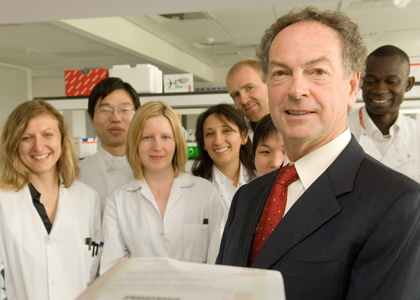Paul O’Gorman Leukaemia Research Centre opens
Published: 21 May 2008
The Paul O’Gorman Leukaemia Research Centre has been opened by Dr Richard Rockefeller.
The Paul O’Gorman Leukaemia Research Centre has been opened by Dr Richard Rockefeller.
The £3million centre is fitted out with the latest technology and will allow specialists to translate laboratory findings into new treatments for patients. It was built after a fundraising drive by the University of Glasgow, which saw more than £2.5million raised in six years.
Opening the centre, Dr. Rockefeller paid tribute to the staff and said their work is vital.
He said: “The leukaemias are among the harshest of cancers. Much progress has been made to date, but a great deal remains to be done. I have chosen to support the POGRC because among all the world’s researchers, Dr. Tessa Holyoake and her extraordinary staff stand out as offering the greatest promise of a medical cure for the leukaemia from which I have suffered.
 “It is my great honour to open the Paul O’Gorman Research Centre.”
“It is my great honour to open the Paul O’Gorman Research Centre.”
Dr. Rockefeller, who is a practicing family physician and also the great-grandson of the industrialist John D. Rockefeller, was diagnosed with chronic myelogenous leukaemia in the year 2000. Thanks to a breakthrough in drug treatment around that time, he is healthy today, though not yet free of the disease.
University of Glasgow Principal, Sir Muir Russell said: “The University of Glasgow is committed to attracting and retaining the best staff by investing in research excellence.
“We are at the forefront of setting and delivering the research agenda, nationally and internationally, across the range of disciplines in which we are active and the completion of this world-class facility is a huge step forward in building our research capacity.
"I would also like to thank all those whose generosity made the completion of the project possible. The University of Glasgow is always extremely grateful for the support of its friends and alumni."”
Tessa Holyoake, University of Glasgow professor of experimental haematology and director of the centre, said: "The key benefits of this new centre derive from the proximity of clinical and laboratory disciplines with all essential components incorporated into a single site. Integration of the NHS and Blood Transfusion Centre offer improved access to blood and bone marrow samples from normal donors, cord blood (normal deliveries) and from patients with the full range of blood cancers.
“The future success of leukaemia research depends entirely on our ability to integrate access to biobanks, established from normal donors and patients with blood cancer.
“Scientists can then interrogate the gene expression, protein expression and metabolism of cancerous cells compared with normal cells and finally to apply these new discoveries in designing clinical trials that give all patients access to more effective therapies.
“The Paul O’Gorman Leukaemia Research Centre has delivered our vision for translational haemato-oncology in Glasgow, bringing together these key elements on a single site.”
Dr David Grant, Director of Research for leading blood cancer charity Leukaemia Research says: “This is great news for the 2,000 plus patients newly diagnosed with a blood cancer in Scotland each year. The world leading research that will be carried out in the new centre will take us closer to cures for leukaemia and the other blood cancers which affect all age groups"
The University of Glasgow launched the Paul O’Gorman Leukaemia Research Centre campaign in 2002, in conjunction with the charity Leukaemia Research in order to build the Centre.
It is named after Paul O’Gorman, who tragically lost his battle with Leukaemia aged just 14. Paul’s parents, Eddie & Marion, set up the charity Children with Leukaemia, which collaborated with Leukaemia Research to help raise the funds needed to get the centre built.
Now the building is open, Leukaemia Research will continue to support the work of Professor Holyoake, whose work is crucial to our understanding of how chronic myeloid leukaemia originates from cancer stem cells.
The Paul O’Gorman Leukaemia Research Centre has been made possible by the commitment and generosity of more than 1800 donors and supporters. The interactive donor wall will be situated in the entrance of the new centre, on the third floor. The wall will feature the inscriptions chosen by those donors to the building who gave through the Appeal.
For more information, contact Ray McHugh in the University of Glasgow Media Relations Office on 0141 330 3535 or email r.mchugh@admin.gla.ac.uk
First published: 21 May 2008
<< May

